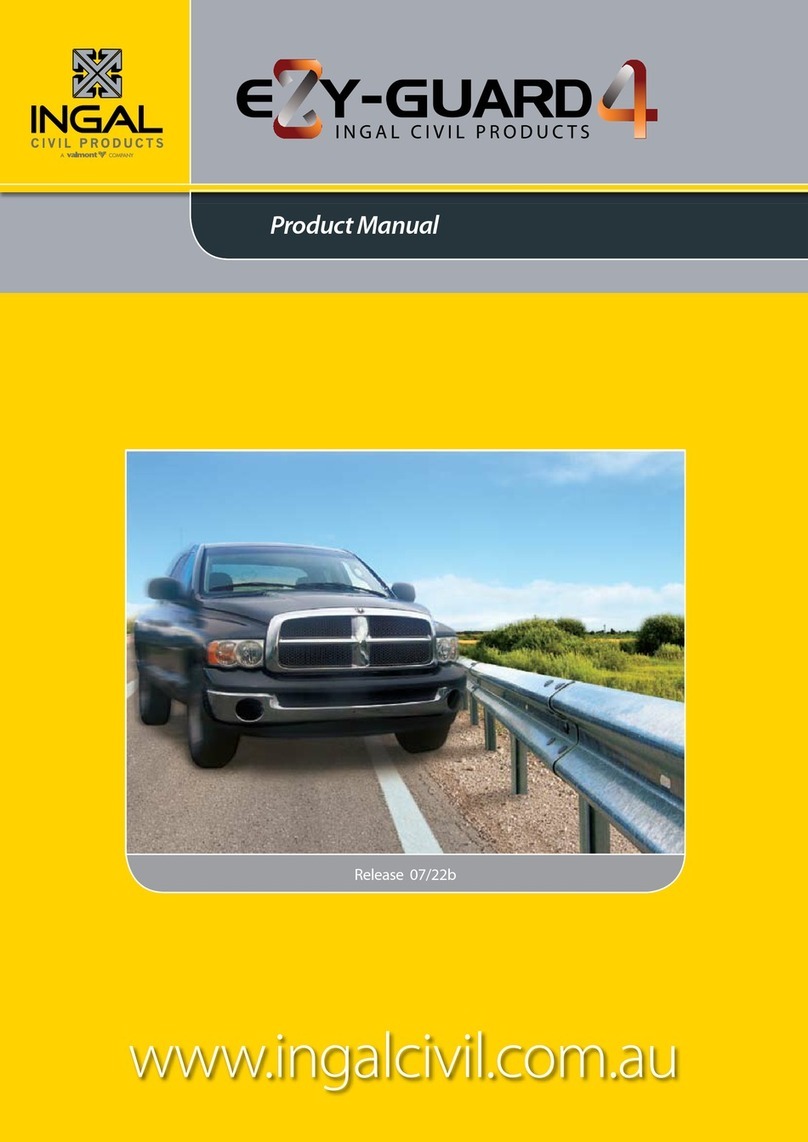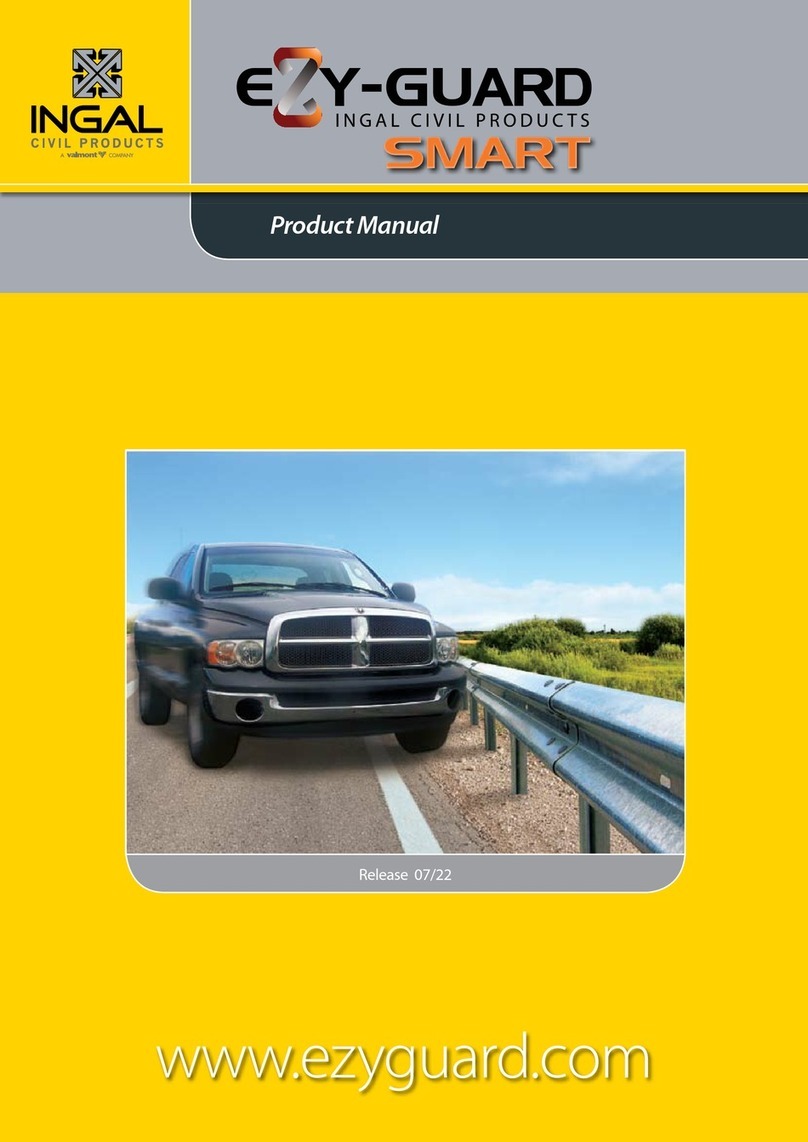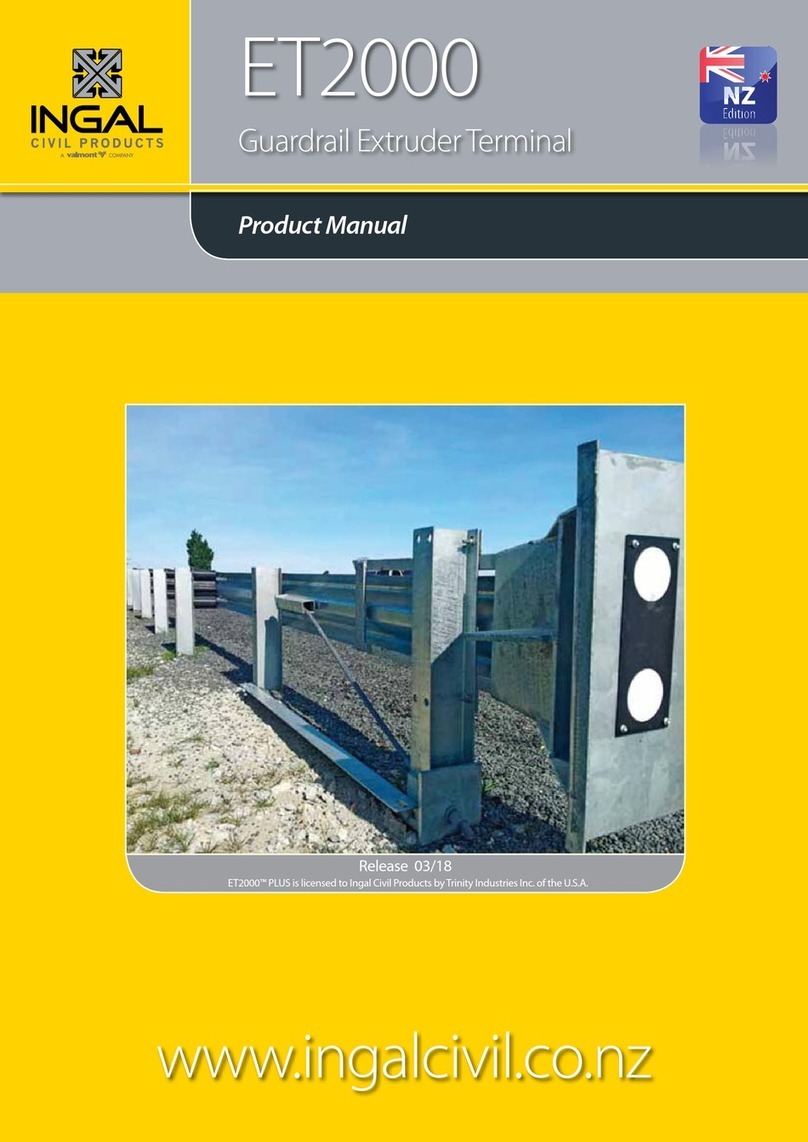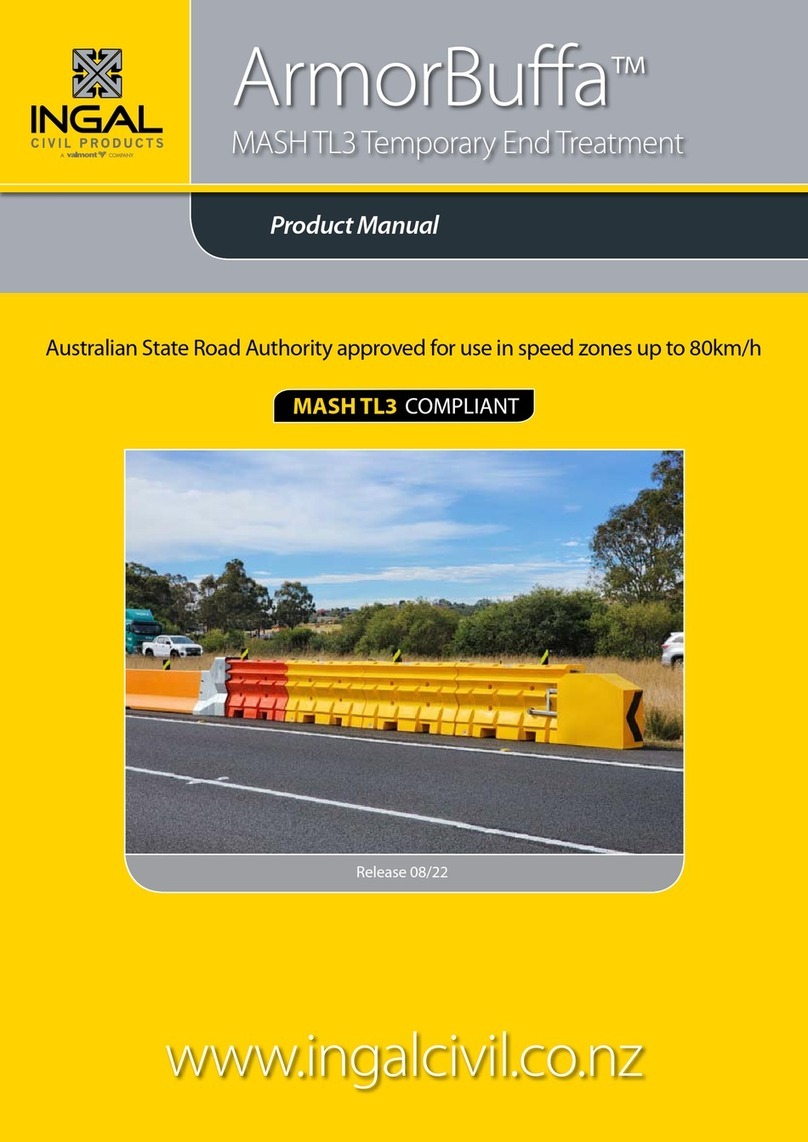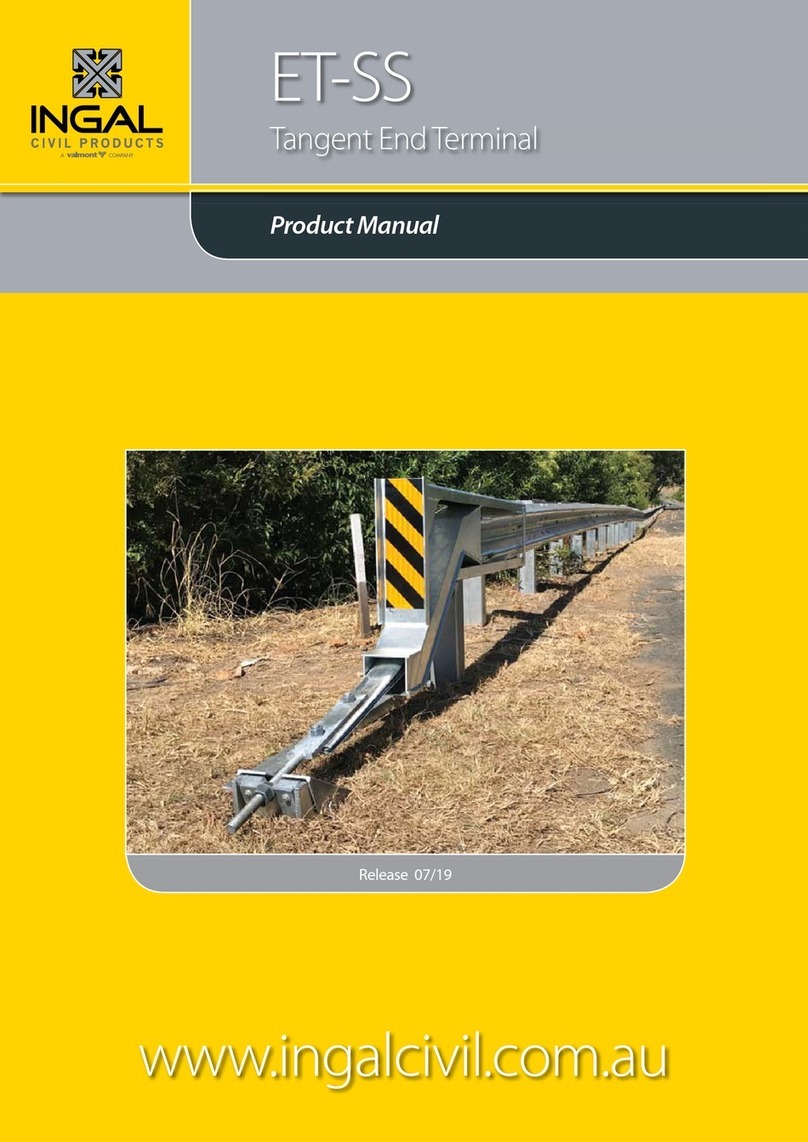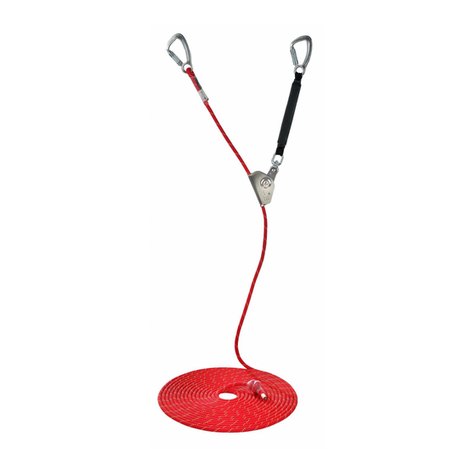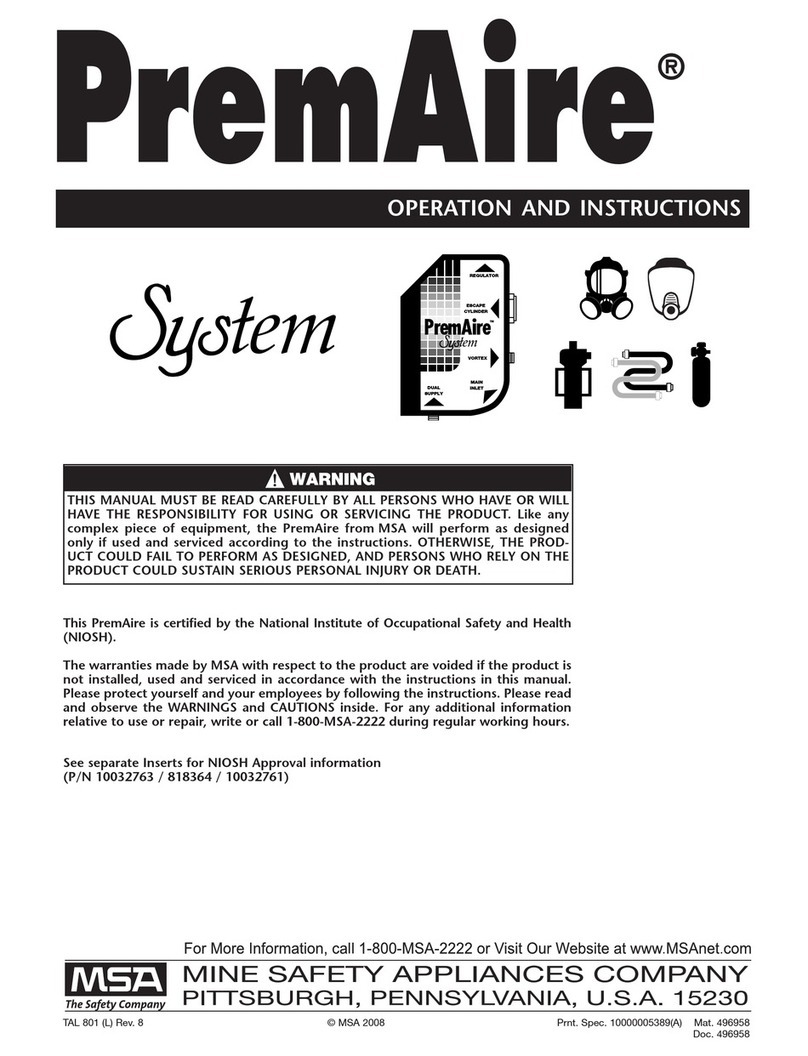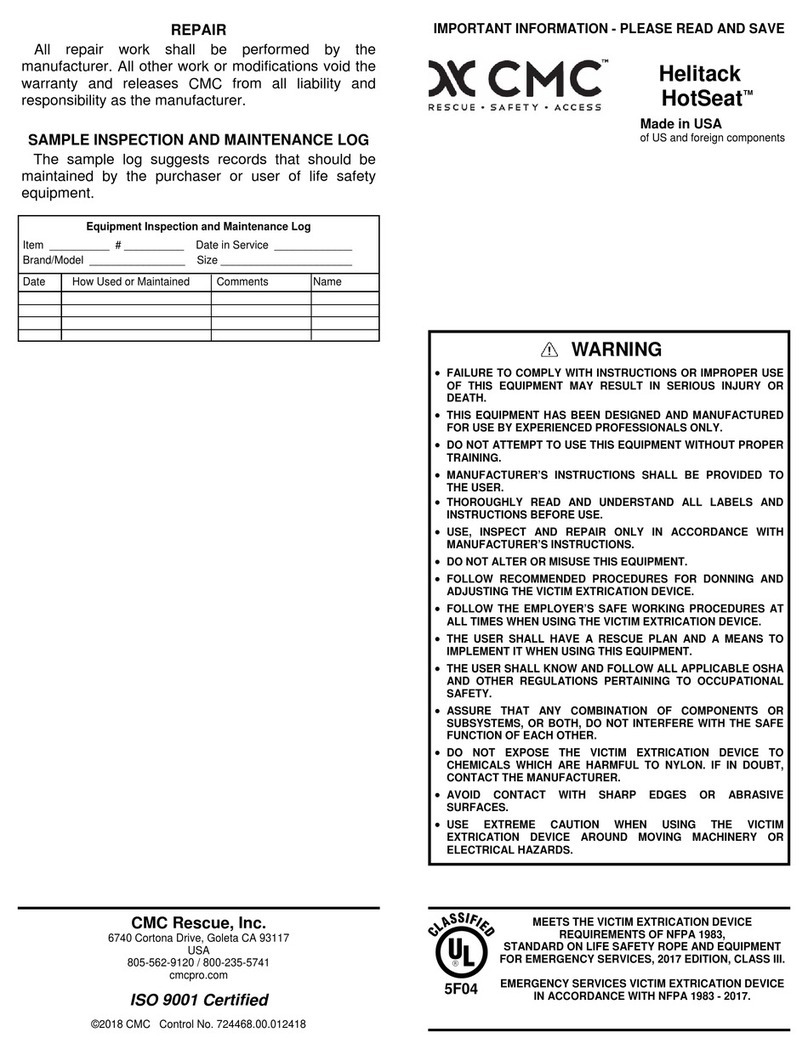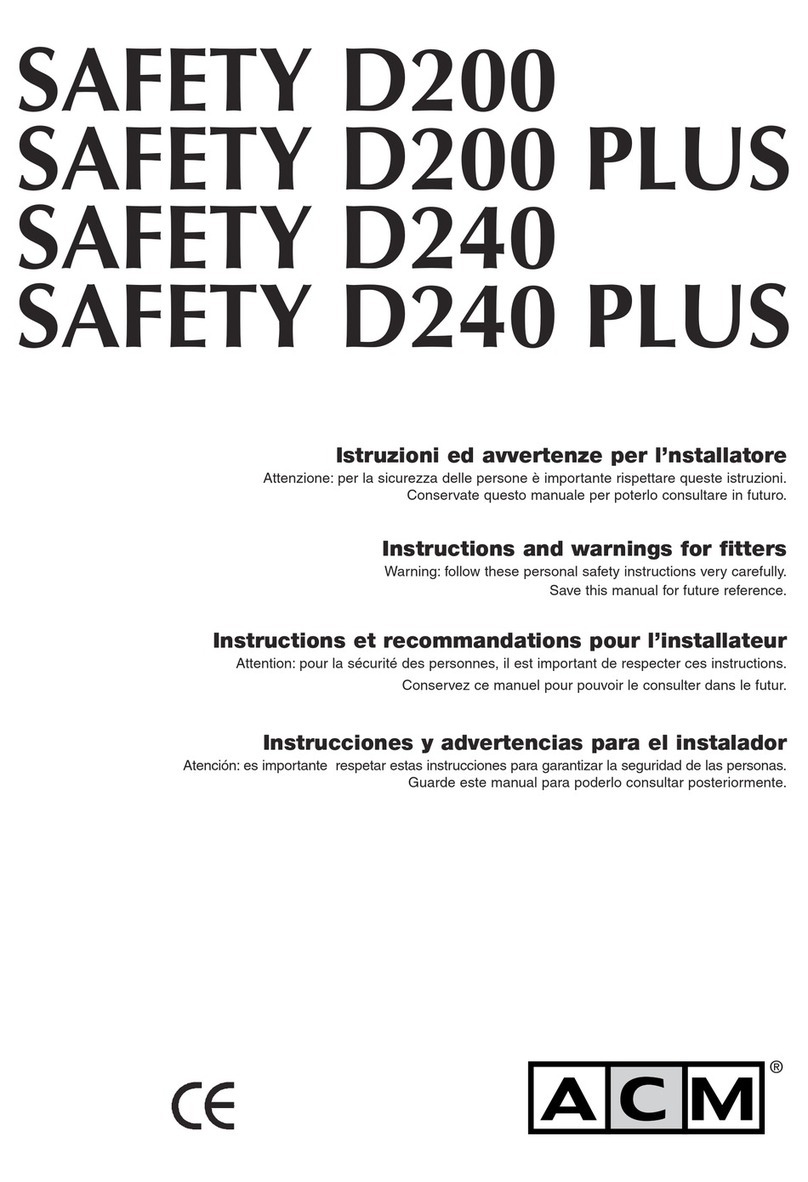INGAL MashFlex User manual

www.ingalcivil.co.nz
Release 07/21a
MashFlex is licensed to Ingal Civil Products by Blue Systems Inc. of Sweden
Product Manual
Wire Rope Safety Barrier
Wire Rope Safety Barrier
MashFlex
MASH TL3
MASH TL4

2
Release 07/21a
MashFlex Wire Rope Safety Barrier
Wire Rope Safety Barrier Wire Rope Safety Barrier
ASH LE
INGAL CIVIL PRODUCTS
ASH LE
INGAL CIVIL PRODUCTS
1.0 Introduction
Introducing MashFlex, a member of the Safence family,
the next generation wire rope safety barrier (WRSB),
providing superior motorist safety and more metres of
barrier for your dollar.
MashFlex is crash tested to the latest performance
standard, the Manual for Assessing Safety Hardware
(MASH) Test Level 3, making it compliant to the current
AS/NZS 3845.1:2015.
The superior design and clean lines of the MashFlex
WRSB have seen it become the road safety industry’s
preferred wire rope barrier. These design characteristics
have continued in this next generation of the product,
MashFlex, with an improved design and simplied
assembly sequence.
With the introduction of the iRAP Star Rating for a
highway’s safety, critical for a 5 Star rating is the separation
of oncoming vehicles and protection from roadside
hazards, WRSB has become a key countermeasure in
these designs. Cross-median accidents are typically
violent collisions with a high probability of multiple
serious injuries and death.
The straight alignment of the ropes allows for easy
installation and tensioning. Post footings are typically
concrete with a sleeve to form a recess. Once the anchors
and footings are poured, the ropes are cut to length,
stainless steel end ttings are machine swaged and the
ropes are tensioned.
MashFlex is a 4-rope barrier assessed in accordance with
MASH Test Level 3 (TL3) and TL4.
Test Level 3 comprises two tests, the heavy vehicle impact
is performed with a 2,270kg pick-up truck travelling at
100km/h and impacting the barrier at 25°, the purpose of
this test is to verify the barrier’s performance for impacts
involving pick-up trucks and SUVs.
The small vehicle impact is performed with an 1,100kg
car travelling at 100km/h and impacting the barrier at
25˚, the purpose of the small car test is to evaluate the
risks to the vehicle occupants when impacting a safety
barrier.
TL4 requires the evaluation of the barrier when impacted
by a 10,000kg rigid truck travelling at 90km/h and
impacting the barrier at 15°, the purpose of this test is
to evaluate the capacity of the barrier to contain and
redirect the vehicle.
2.0 Specication
Material:
Steel Wire Rope: Mass – 1.21kg/m
Ultimate Tensile Strength – 165.5kN
Sigma Posts: Material to AS/NZS 1594
Anchor Bracket: Material to AS/NZS 1594
Swage Fittings: Stainless Steel, Grade 304
Plastic Parts: UV Stabilised Polypropylene
Finish:
Steel Wire Rope: Galvanised coating
Sigma Posts: Galvanised to AS/NZS 4680
Anchor Bracket: Galvanised to AS/NZS 4680
Dimensions:
Steel Wire Rope: Right Hand Lay, Ø19mm, 3 strands,
7 wires each (1 x 3.15mm + 6 x 3.0mm)
Sigma Posts: 1230mm long
Sigma Posts:
1230mm long
Figure 1: MashFlex Wire Rope Safety Barrier

Wire Rope Safety Barrier Wire Rope Safety Barrier
ASH LE
INGAL CIVIL PRODUCTS
ASH LE
INGAL CIVIL PRODUCTS
3
Release 07/21a
MashFlex Wire Rope Safety Barrier
3.0 Technical Data
3.1 MashFlex Performance
Wire rope safety barriers are classied as exible barriers
and consideration must be given to the expected
movement of the barrier when impacted.
The design of a WRSB should include an assessment of
the mass of the impacting vehicle, its speed and angle
of impact. Whilst rigorous crash testing is undertaken
to evaluate the performance of roadside barriers, the
deection results obtained during testing should not be
considered an exact distance, but rather as a single point
within the range of deections that can be expected.
3.2 Working Width
The working width is the maximum width that is required
to prevent an impacting vehicle from colliding with an
object behind a road safety barrier system. This includes
the dynamic deection and the extra width due to the
roll of an impacting vehicle. The roll of a vehicle is an
important consideration in shielding a xed object hazard
such as a utility pole or bridge support. Refer to Table 2 for
tested working widths and Fig. 2 for more detail.
3.3 Dynamic Deection
The dynamic deection is dened as the largest
transverse deection of a road safety barrier system
recorded during crash testing. Refer to Table 2 for tested
deections and Fig. 2 for more detail .
If the available space between the hazard and the barrier
is not adequate, then the barrier can be stiened in
advance of, and alongside the hazard by reducing the
post spacing. Other factors that can have an inuence on
the deection of the barrier include tension in the wire
rope cables, horizontal curvature and installation length.
3.4 Footing Selection
The post footing provides lateral support to the post
during impact ensuring the post yields by bending near
ground level. The type and size of footing is dependant
upon the surrounding soil type and distance to the
embankment rounding point.
Table 1 provides guidelines for the construction of
concrete post footings for varying site conditions. If using
the Driven Sleeve footing option, please refer to drawing
WR-MF-002 and asset owner acceptance conditions
prior to installation.
prior to installation.
Figure 2: Barrier Displacement Terminology
Allowance for
system width
and/or vehicle roll
Working Width
SystemWidth
Dynamic Deection
(may be 0m with rigid barriers)
Safety
Barrier
Limit of
Dynamic
Deection
Initial position of barrier
Vehicle roll is slope line
Object
requiring
protection
from impact
Deected position of barrier
prior to installation.
prior to installation.

4
Release 07/21a
MashFlex Wire Rope Safety Barrier
Wire Rope Safety Barrier Wire Rope Safety Barrier
ASH LE
INGAL CIVIL PRODUCTS
ASH LE
INGAL CIVIL PRODUCTS
Table 1: Post Footing Selection Guide
Centre of Post Footing to
Rounding Point
Standard Soil Weak Soil
Dia Depth Dia Depth
Less than 0.5m 300 600 300 750
Greater than 0.5m 300 600 300 750
The minimum concrete compressive strength at 28 days
is 30Mpa.
In the event that the soil type cannot be veried, then
a post pull-over test can be conducted to validate the
structural capacity of the footing.
A pull-over test is conducted by applying a load to the
top of the post whilst positioned in the proposed footing
design. The footing is required to remain stable until the
post yields. Once the post yields, the footing has been
subjected to its maximum potential load.
For locations where the typical 600mm deep post
foundation cannot be installed, a strip footing with post
on baseplates is an alternative option, refer drawing
WR-MF-003 for further detail.
3.5 Minimum Length
There are two geometric methods used to determine
the likely trajectory of a vehicle that leaves the road in the
vicinity of a roadside hazard and the minimum length of
barrier required to protect from this hazard.
The most common method is the run-out length
method and an alternative is a method based on angle
of departure.
Prior to design or installation, designers should consult
the relevant road controlling authority to establish the
local jurisdictional practice as the methods may result
in dierent lengths. Both methods are detailed in the
Austroads Guide to Road Design – Part 6.3.
For instances where geometric constraints limit the
installation of the recommended length under the
above design methods, the absolute minimum length of
minimum length of need for a run of MashFlex is 70m, this
includes a TL3 Terminal on both ends. These installations
should be considered within the requirements of the
road controlling authority’s Extended Design Domain.
3.6 Maximum Length
Please refer to your local road controlling authority for their
max run length recommendation.
3.7 Point-of-Need
MashFlex is designed to contain and redirect errant
vehicles away from road side hazards. The location along
the barrier system that redirection occurs is known as the
point-of-need.
The point-of need for the MashFlex system is 11.73m
from the anchor point when using the MASH TL3 End
Terminal.
barrier required to protect from this hazard.
Terminal.

Wire Rope Safety Barrier Wire Rope Safety Barrier
ASH LE
INGAL CIVIL PRODUCTS
ASH LE
INGAL CIVIL PRODUCTS
5
Release 07/21a
MashFlex Wire Rope Safety Barrier
4.0 List of Components
Table 2: Crash Test Performance
Containment Level Vehicle Weight Impact Speed Impact Angle Post Spacing Deection Working Width
MASHTL3 2270 kg 100 km/h 25˚ 2.5m 2.19m 2.19m
MASHTL3 2270 kg 100 km/h 25˚ 3m 2.68m 2.73m
ID COMPONENT PN
MashFlex System Components
AMashFlex Post 1230mm 10009358
BMashFlex Cap 10009397
CMashFlex Plug 10009421
DMashFlex Plastic Sleeve 10009420
EPost Ground Cover 10006740
FStainless Steel Tension Fitting 10001534
GReo Ring 10001580
Terminal Components
T1 Safence Post 1180mm 10001671
T2 Safence Short Post 700mm 10009431
T3 Safence Steel Spreader 4 Rope 10001570
T4 Safence Plastic Cap 10001563
T5 Safence Stainless Steel Frame 10001560
T6 TL3 Safence Ground Cover 10001566
T7 Safence Anchor Bracket 10001574
T8 Cable End Fitting 10001530
T9 M24 Stainless Steel Washer 10001531
T10 M24 Stainless Steel Nut 10001532
T11 Hook Bolt Kit 10008876
T12 M20 x 350mm Hex Bolt/Nut & Washer 10009445
T13 Flexfence Type 3 Reo SL81 Mesh (default) 10008518
T14 Flexfence Type 1 Reo SL81 Mesh (alternative) 10001581
Alternative Congurations Components
ZA MashFlex Driven Sleeve 10007593
ZB MashFlex Post on Baseplate 10009425
Table of contents
Other INGAL Safety Equipment manuals
Popular Safety Equipment manuals by other brands
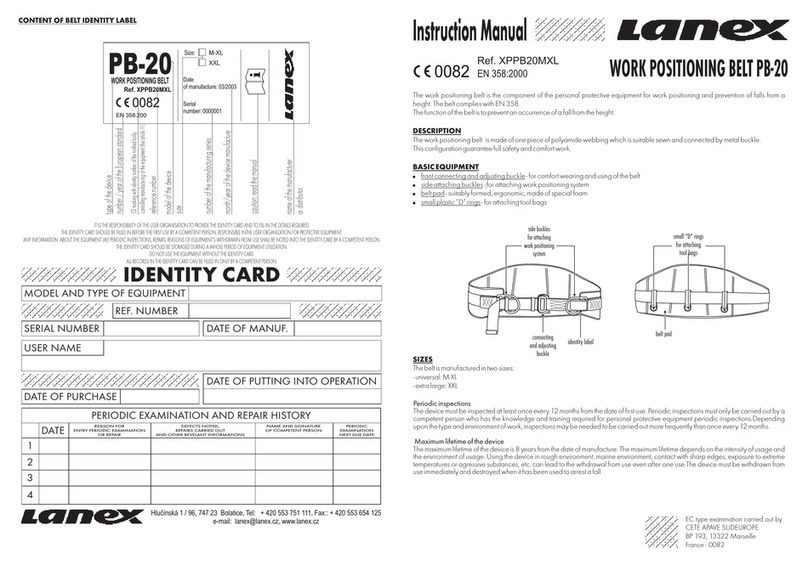
Lanex
Lanex PB-20 instruction manual
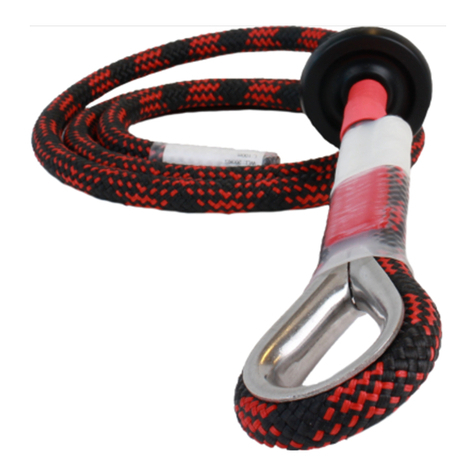
SKYLOTEC
SKYLOTEC ANCHOR ROPES Instructions for use

Besto
Besto Buoyancy Aid 50N Instructions for use

TEUFELBERGER
TEUFELBERGER NODUS Manufacturer's information and instructions for use

Troy Lee Designs
Troy Lee Designs Tbone Product owners manual
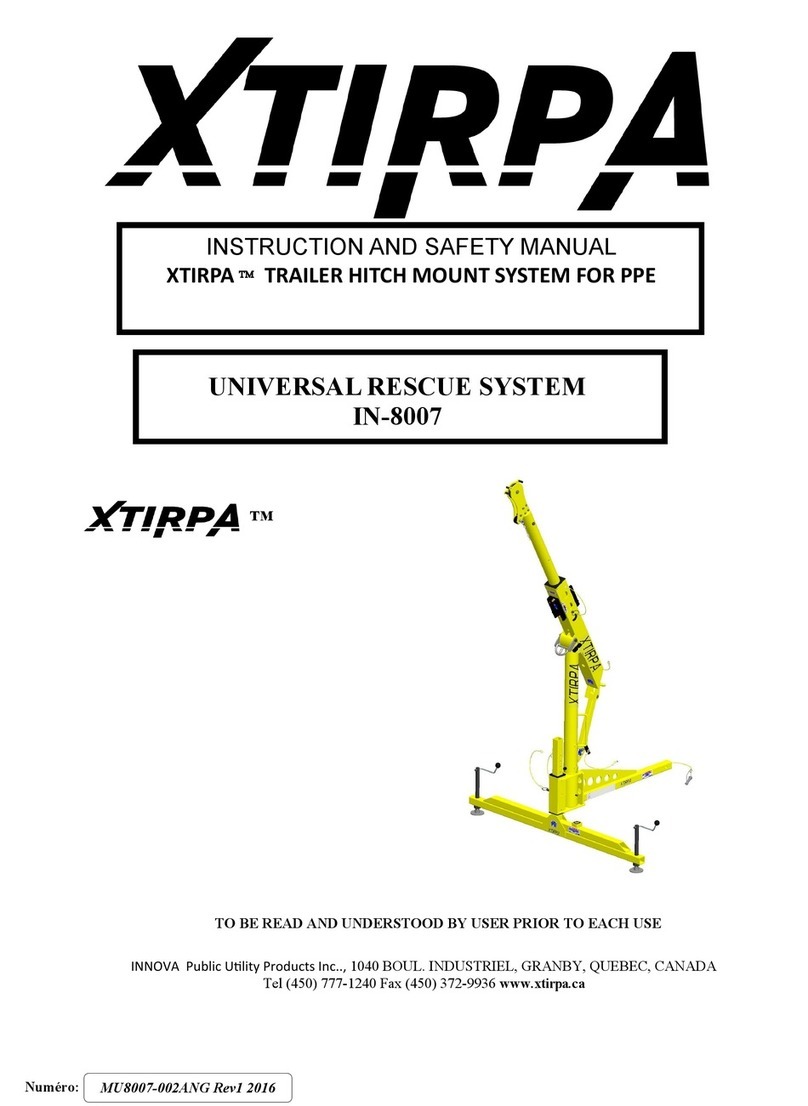
Innova
Innova Xtirpa Instruction and safety manual

bolle SAFETY
bolle SAFETY B810 quick start guide
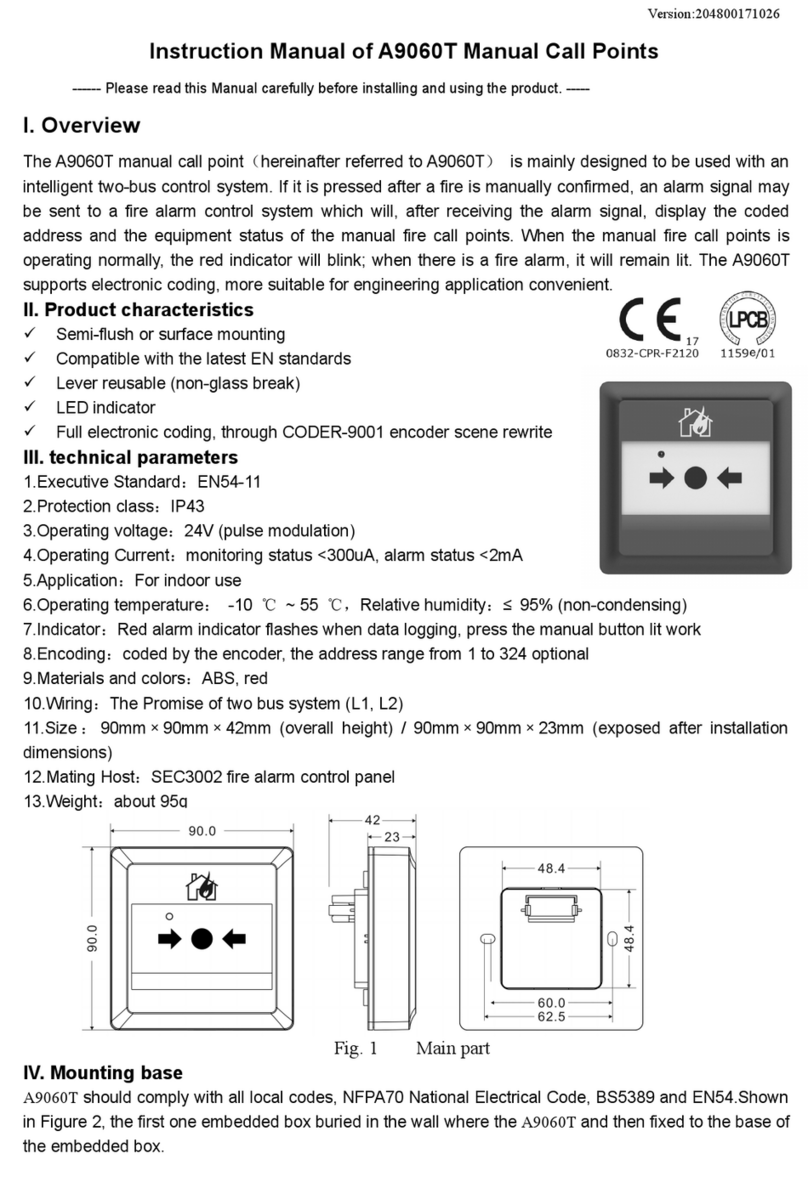
SHENZHEN FANHAI SANJIANG ELECTRONICS
SHENZHEN FANHAI SANJIANG ELECTRONICS A9060T instruction manual
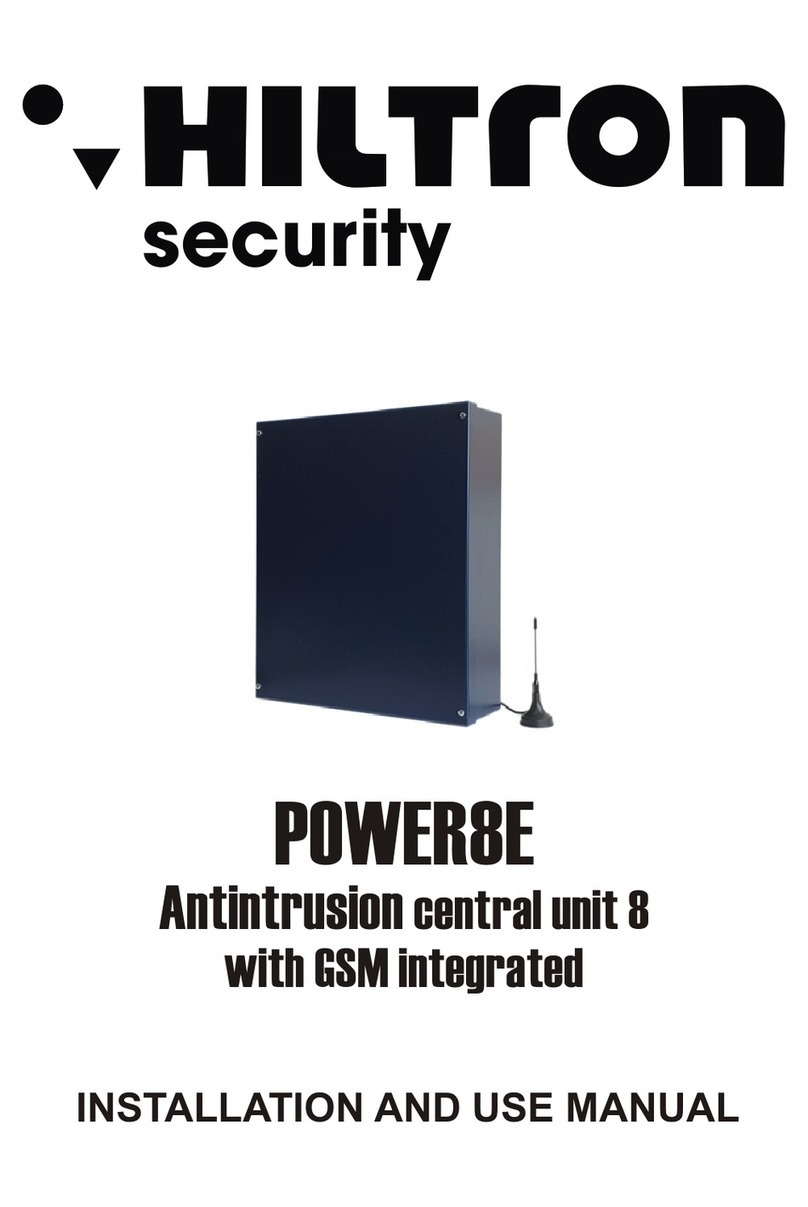
Hiltron security
Hiltron security POWER8E Installation and use manual

Salewa
Salewa MTN SPIKE user manual
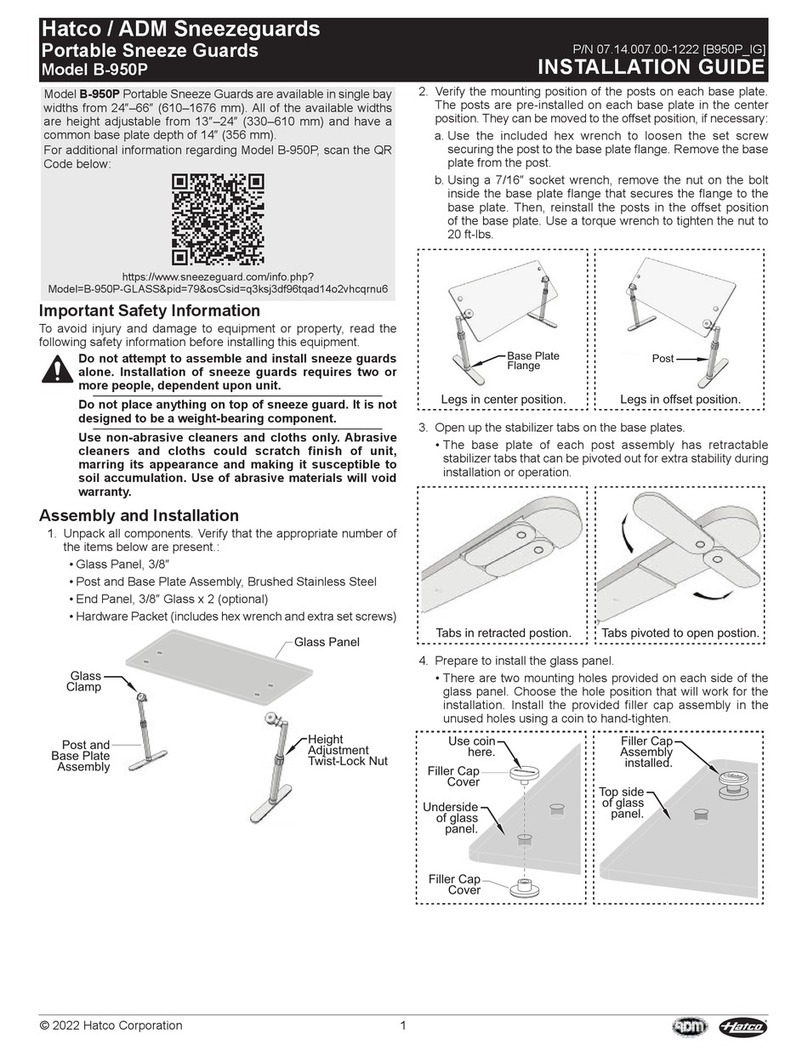
Hatco
Hatco B-950P installation guide
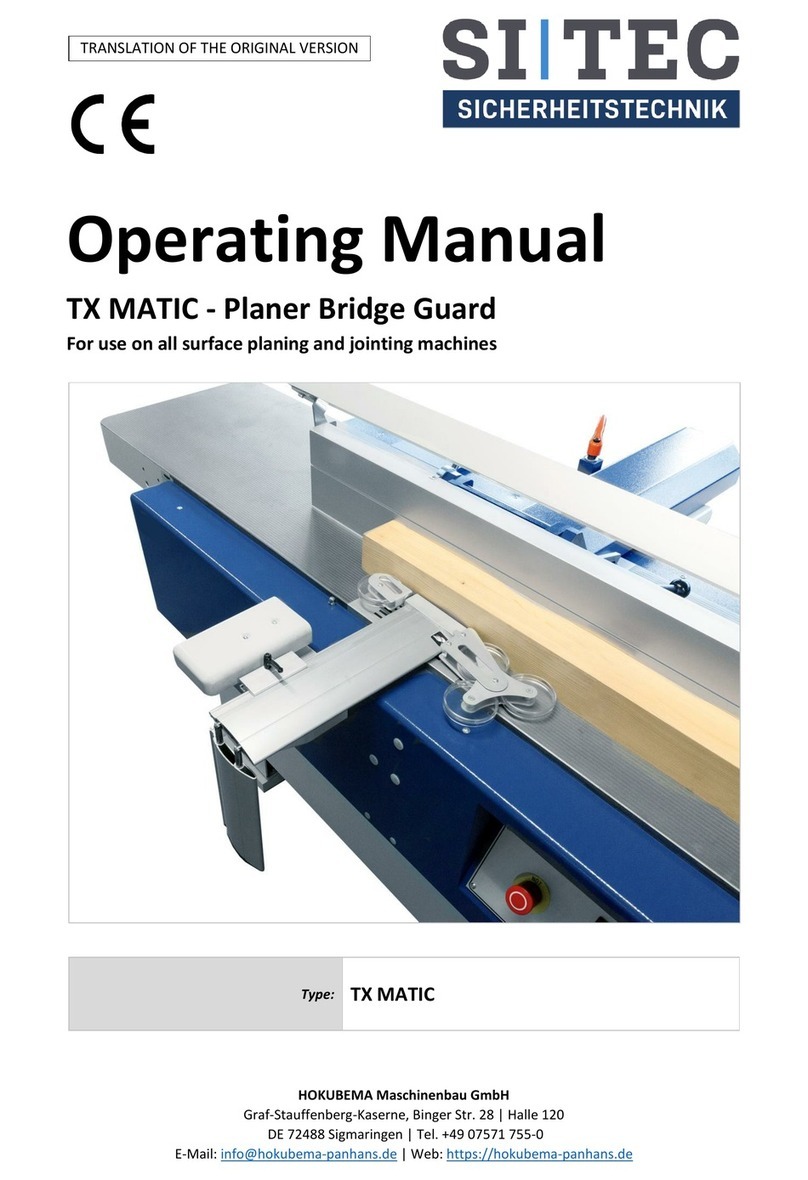
Sitec
Sitec TX MATIC operating manual
